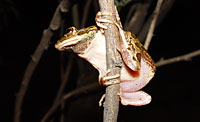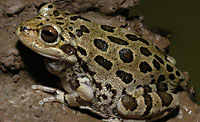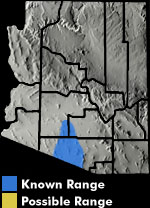Online Field Guide to The Reptiles and Amphibians of Arizona


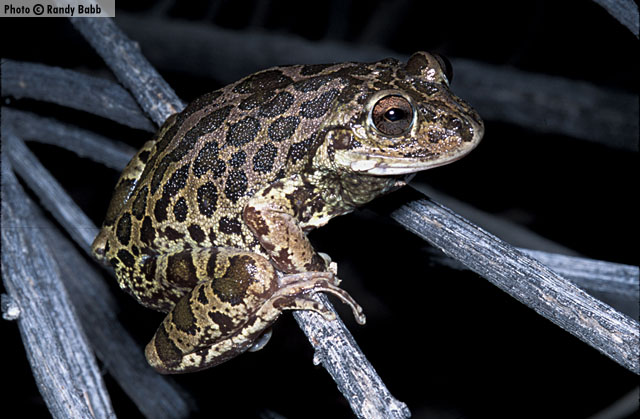
Pima County, AZ
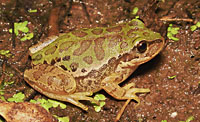 Juvenile. Pima Co., AZ |
||
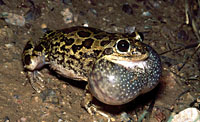 Calling. Maricopa Co., AZ |
| LOWLAND BURROWING TREEFROG Smilisca fodiens |
|
|
DESCRIPTION: A casque-headed hylid frog, this species has a very hard upper surface of the skull to which the skin is firmly attached. There is a noticeable ridge between the eye and the nostril, and a fold of skin at the back of the head. Coloration is yellow-brown with dark olive brown blotches. The snout is rounded and the jaws are flattened, giving a slight duck-billed appearance. The fingers are long and slender, having small discs. Adults reach about 2.5 inches in length. Adult males have a dark throat patch during the breeding season. Juveniles are greenish with irregular brown spots and a dark stripe that runs between the eye and the nostril, similar to the Arizona and Pacific treefrogs. Tadpoles are dull tan with olive brown mottling dorsally, and the belly is white. Dark brown spots are also present on the caudal fins and a white stripe may be present between the eyes. Tadpoles grow to about 1.75 inches. DISTRIBUTION: Inhabits mostly xeric regions from south-central Arizona southward through western Sonora to Michoacan. The Arizona localities are mainly associated with washes that flow towards Mexico, such as Santa Rosa and San Simon washes on the Tohono O’odham Nation. The species was recently found in the Vekol Valley south of Interstate 8. Lowland burrowing treefrogs were unknown from Arizona and the United States until 1957. HABITAT: In Arizona, this frog inhabits valleys within Sonoran Desertscrub, often where mesquite is common. To the south, it also occurs in thornscrub, tropical deciduous forest, and other xeric habitats. BEHAVIOR: Similar to spadefoots, this species spends the majority of the year underground and emerges with the first, substantial summer rains. While dormant underground, it forms a cocoon of multiple layers of stratum corneum (the outermost layer of the epidermis) that is perforated only at the nostrils. This cocoon prevents desiccation. Firschein (1951) described the unken reflex in this species, which consists of flexing the head downward and elevating the limbs so as to rest on the belly. The purpose of this behavior may be to close burrows in the ground. Lowland burrowing treefrogs are typically found on the ground, but they can climb short distances into trees and shrubs. REPRODUCTION AND CALLS: Breeding occurs “explosively” during the summer rains from late June into September. After the first substantial storm, Lowland burrowing treefrogs gather around temporary pools that form in washes, cattle tanks, or other impoundments. The advertisement calls, given at night by males, are low-pitched notes resembling the quack of a duck. Males also give what may be a territorial call, similar to the advertisement call of the Western chorus frog. Males call from secluded places, often out of water, but near breeding pools. Clutch size and larval developmental times are unknown. DIET: Unknown, but presumably Lowland burrowing treefrogs eat a variety of arthropods. REMARKS: Until recently, this species was considered in the genus Pternohyla. The Lowland burrowing treefrog is a tropical or subtropical species that reaches its northern limit in southern Arizona. By Ernest Nigro and Jim Rorabaugh
Duellman, W.E. 2001. The Hylid Frogs of Middle America. Expanded edition. Society for the Study of Amphibians and Reptiles, St. Louis, MO. Firschein, I. L. 1951. Phragmosis and the “unken reflex” in a Mexican hylid frog, Pternohyla fodiens. Copeia 1951 (1):74. Sredl, M.J. 2005. Pternohyla fodiens Boulenger, 1882 Lowland burrowing treefrog. Pages 488-489 in M.J. Lannoo (ed), Amphibian Declines: The Conservation Status of United States Species. University of California Press, Berkeley, CA. Sullivan, B.K., R.W. Bowker, K.B. Malmos, and E.A. Gergus. 1996. Arizona distribution of three Sonoran Desert anurans: Bufo retiformis, Gastrophryne olivacea, and Pternohyla fodiens. Report to the Arizona Game and Fish Department, Phoenix, AZ. Trueb, L. 1969. Pternohyla, P. dentata, P. fodiens. Catalogue of American Amphibians and Reptiles. (77):1-4. |
|
Visit Partners in Amphibian and Reptile Conservation:


HOME
Copyright © 2023, Arizona Game and Fish Department. All rights reserved.
If you make use of the textual contents of this site in reports, publications, etc. please cite and credit the author(s) and photographer(s). All photos on this website are copyrighted. However, those found in the species account section may be used for any noncommercial scientific, educational, or conservation purposes provided that photographs are not altered and continue to bear the copyright symbol and name of the photographer. Please contact the photographer regarding commercial use of copyrighted photographs.










